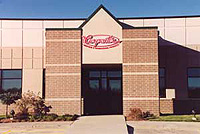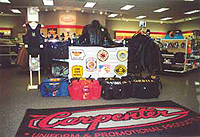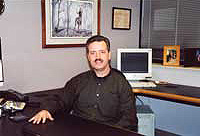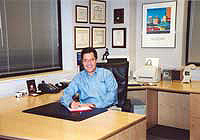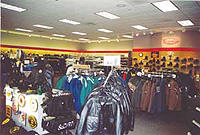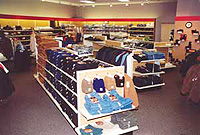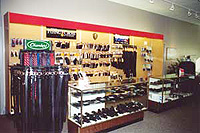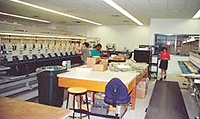|
By Susan Derby
Things were looking a little unsure for Carpenter Uniform and Promotional Products two years ago. Split between two buildings and facing forced removal from one of them, owner Bob Carpenter made the decision to not be pushed around. He instead called on his education and the help of co-manager Dennis Gruss to fight off the citys eviction notice while designing and building what would become the new home of both divisions.
The city of Des Moines condemned a five-block area of the downtown for a new insurance building. Originally, we didnt think that our building would be in the way of any project in that area, but it turned out to be a big project. Carpenter says. So at a pretty short notice, we had to high tail it out of there.
The 49-year-old company had been at its location for 26 years and was very settled into the building. It was the location Bobs parents and company founders Morrie and Ruth Carpenter chose after outgrowing the first location in downtown Des Moines, Iowa.
To make matters a bit worse, the more recently added promotional products division was in a building just a few blocks away from the central uniform building, and there was no eviction for that building. So Carpenter was facing forced removal from the companys home of 26 years but not from the related Carpenter Promotional Products building. It proved difficult to find a new home for Carpenter Uniform close to the other division at a reasonable price.
Carpenter says, We knew for a couple of months that the development was going to take over our area, but we didnt know the time frame. The city came to us in April and told us what they wanted to pay for the building and that they wanted to take possession by Oct. 31, 2000. So it was a six-month notice. In that time span, Bob Carpenter searched for existing buildings in the Des Moines area that would be able to hold both operations. After failing to find a suitable location, he ultimately decided to use some undeveloped property he had purchased years earlier. He says he always had the desire to build on that property, but he didnt have any actual plans and wasnt even sure he wanted to build a new facility for the public safety uniforming operation.
Searching for the new facility wasnt the only battle going on at that time. Carpenter was using his legal degree and experience to put off the city for a little more time. By the date the city required the company to be out of the old building, they had just broken ground for the brand new building. There was no way the machinery, merchandise and offices would have anywhere to go for quite some time. So Carpenter filed an appeal, saying the city would have to pay to move him twice if they forced him out before the new building was ready; a two-phase move was something neither side wanted.
Finally we came to an agreement where they saw that my legal background would help me stretch this thing out as long as I needed to. So we came up with a solution that moved all of the alteration equipment and our warehouse which is a lot of clothing and racks out to the new building that was still under construction, and the city would grant a partial occupancy permit for the unfinished building. We moved the retail store and the offices into the Carpenter Promotions building, which was not being taken by the city. We operated out of the two separate facilities for three months, and in June 2001, we moved the rest of the operation out to the new building.
And what a new building it is! The huge 27,000-square-foot facility is more than three times the size of the old building. Though they are using only 18,000 square feet currently and reserving the other part for subleasing, the custom design and layout have made huge improvements on how the showroom, warehouse and employees operate as one single unit.
Carpenter Uniform and Promotional Products is a perfect example of the old clich When life gives you lemons, make lemonade. When the city of Des Moines gives you a condemnation notice, build the perfect facility.
Carpenter Uniform Company was founded in 1954. Through its expansion and moving to a new facility in 1974, two things have remained the same: its service to police, security, paramedics and other public safety personnel, and its tradition of family ownership. Bob Carpenter grew up in the business and learned many aspects of it from his parents. After earning his law degree and practicing for a few years, he returned to the family business in the late 1970s with a new interest; he wanted to expand into imprinted sportswear and screen-printing of promotional products. By 1981, there was enough equipment and business printing mostly t-shirts, jackets and hatsto move that end of the business to its own building. Carpenter Promotions was created and located just a few blocks from Carpenter Uniform, and Bob had major control of its operation.
Shortly before Bobs return to the family business, Dennis Gruss came to work for Morrie and Ruth Carpenter. Gruss, fresh out of college with a degree in business administration, caught the clothing bug from his work in a hometown retail clothing store.
Gruss says, Mr. Carpenter made me an offer I couldnt refuse, so I have been here since 1976 working with Bob, and I have seen a lot of changes. Gruss quickly became like another son of Morrie and Ruth.
Bob laughs while he explains, Dennis was the good son. Dennis always said Yes, Mr. Carpenter. I always said Well, why dad?
What started as a single company had become two related but very separate businesses. Two operators had become four. One location downtown had been moved to another that had grown into two. Plus, Carpenter Uniform bought out Metro, another uniform retail shop in Des Moines, adding to the product line and the warehouse demands. Carpenter Uniform Company and Carpenter Promotions were both enjoying separate success, and both of the younger managers were learning not only the business but also the service that went along with public safety uniforming.
Dad retired in 1986, and he passed away in 1992. My mom just passed away last year in June, 2001, so Dennis and I have been running the store, Bob says. The way it worked out for a number of years was that I ran the promotional products business and Dennis worked exclusively in the uniform company.
The necessary move in 2001 became a way to join the two separate companies back into a single unit. The new facility was larger than both of the other two combined. But it was a little more off the beaten path than the old location in downtown Des Moines.
With this type of uniform company, we didnt need a real strong retail location, but I didnt want to be in a warehouse district or in a rundown old building that was going to be condemned next, Carpenter says. We selected more of an office park for our location. Its a nice mix of commercial and light industrial operations here. Our building is about 200 feet off the street. Its not close to a well-traveled street, so we really dont have any window displays. We dont have a retail look; we have more of an office look from the outside of the building.
Carpenters plan is to rent out one third of the building to another business, hopefully one thats related to public safety uniforming or promotional products. That space can generate profits now but also reserves some space for expansion into the future. Of the 18,000 square feet the company is using, it is roughly divided into four 4,500-square-foot sections: the retail showroom, the warehouse and additional merchandise, the alteration department, and the offices.
Gruss explains how customizing the building helped every aspect of the companys operation and the customers satisfaction. We have the showroom right in the center of our building. As you drive into the parking lot, you come up to the entrance to the showroom, and we have a nice sign over it. About half of the store is taken up with public safety equipment and apparel, and the other half of the store is divided among postal, career apparel and industrial uniforms. We also have an area of the store set up for displaying our advertising specialty products and imprinted sportswear. We have a wonderful fitting area with four dressing rooms and a nice floor-to-ceiling mirror set that gives it a little privacy.
The salespeople have desks along the front walls of the showroom. Because window displays would be ineffective, Carpenter and Gruss decided to put personnel at the windows to improve their workstations with natural light and views. As you walk into the store, salespeople are right there at the workstations ready to take orders and help customers find what they need.
Merchandise is set up on gondolas in the center of the showroom and on slot-walls around the perimeter. Many of the fixtures were bought in 1974 or were acquired when Carpenter bought Metro, but their versatility made them easy to update for the new store environment. A designer helped them get the right look and lighting to make it all come together. Now, everything can be moved and rearranged anytime the layout gets stale or new merchandise is added.
The layout surrounding the showroom is just as unique. With the showroom in the middle of the building, as Gruss explained, the warehouse wraps around part of it, making quick access to more merchandise.
Carpenter explains more. We tried to situate merchandise on the showroom floor and in the warehouse so it would be easy for the salesperson waiting on the customer to get merchandise from the back room where it is stored. For example, the shoes are in the back of the store, and the shoe section of the warehouse is right behind it. I think its very important logistically to have the showroom floor near the merchandise in the warehouse. And just kitty-corner from the showroom is the alteration department.
Even the new loading dock got some close attention. Now that trucks can drive right up and unload merchandise still on the pallets, its much easier to move whole pallets around the warehouse instead of moving individual shipping cartons by hand, as employees did in the old facility.
Carpenter Uniform and Promotional Products employs 22 people, including six in sewing and alterations, one in warehouse, seven in sales and seven in the office. Somehow that handful manages everything from custom artwork on coffee mugs to blue striping on police uniforms. There is competition for general work clothing, imprinted sportswear and advertising specialties from other area companies. But as for public safety clothing and equipment, Carpenter Uniform and Promotional Products is the only one to offer local service to the Des Moines area, according to Carpenter.
Mr. Carpenter had a lot of sayings, and one of them was We are an oasis out here in the desert, says Gruss. Customers who need these products walk in and walk out with a complete set of uniforms and equipment to wear. We are one of the few companies who could fulfill all of that in a one-stop shop.
Gruss credits Carpenters organization as a huge asset to keeping up with the uniform demands of each individual department. The business carries every patch, stripe, pocket, emblem and decoration for each group they have a relationship with. They have all the necessary tailoring machines: four straight-stitchers, two blind stitch hemmers, three post machines (two just for striping), one pant pinking machine, one serger and button-hole machine, one special belt loop machine for making utility pockets and a pressing machine. Plus there are the embroidery machines, including two 12-head and one two-head multi-color Baruden machines. While the simpler alterations and tailoring can be done on the spot for a customer, more extensive customizing takes a little longer.
Gruss says, We do an incredible amount of embroidery and tailoring right here. We dont have to outsource that work. We have control of the time, the quality and the pace of that work, so thats a real advantage. We have all the right equipment. I am surprised that a lot of companies dont have that equipment as part of their operations.
As for the promotional items, best sellers are t-shirts, caps and calendars. Carpenter says hats have come a long way in terms of style in the past few years. For several wearables, the popularity of screen-printing has been replaced by higher-quality embroidery. The screen-printing machines the company used to own were sold to a local screen printer in return for an ongoing agreement with the screen printer for contract printing service.
Like most public safety apparel companies, Carpenter depends on word of mouth as the main source of advertising and new business. Gruss and other sales staff attend about a dozen trade shows in Iowa each year for various organizations.
Another source of business comes from building synergy between the uniform and the promotional products sides of the company. Now in one building, Carpenter and Gruss have been working to cross-train both staffs to sell each others merchandise. One example is the Iowa State Sheriffs Department. As established uniform customers, Carpenter added on an entire catalog of items from coffee travel mugs to shirts. Each county can customize the statewide merchandise with its own name.
Both product lines require a great deal of specialized knowledge, Carpenter has discovered. There are some people that are very adept at selling uniforms, and others are very adept at selling promotional products. Its hard for all of our salespeople to be equally knowledgeable about all of the products that we sell.
For each side, there are also unique challenges. Carpenter says the hardest part of the promotional side is the competition. I think there is overcapacity in the industry. There is competition from the screen printers, office supply companies, advertising specialty companies, local and catalog promotion, and on and on. And the nature of the promotional product business is a series of individual promotions, so one thing thats a hit this year doesnt recur next year. Its all very exciting and fun, but its not an easy business.
Gruss echoes that sentiment about uniforms and apparel. I have been in this business for 26 years selling uniforms and equipment, and its constantly changing. There are new products all the time to be on top of, and we have to track each little piece of the uniform. Relationships are so important in this business. We do a lot to set up programs for the various police departments, fire departments, EMS departments and businesses.
Another thing that helps is a good partner. Carpenter and Gruss seem to compliment each other in both personality and business style. Though they once divided the uniform and promotional products departments, they are now sharing both product lines and are making progress at aligning the two even more closely.
Its fun working with Dennis because I can still be like the son to my father. I say, Dennis, I know you have been doing it that way for 25 years, but why? Can we do it a little differently here? So now that were working together, I think that I am stirring up a few things. Dennis is teaching me a lot, and I am getting him to re-evaluate some of the things we do. Generally we are having a good time working here.
Looking to 2003, Carpenter Uniform and Promotional Products has two main goals. First, it will implement an industry-specific computer system to track and manage inventory and customer service. Preferences and customization will be logged for each client, making service faster and more complete. The second goal, and the major focus, will be improving sales and marketing. Its no doubt that the new facility, with its integrated departments, computerization and well-planned layout, will be a big part of that effort. The company has made some great lemonade from the lemons it was handed. That attitude will assure its success for another 30 years and beyond.
|




